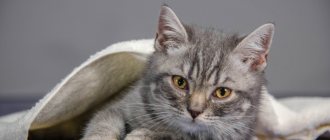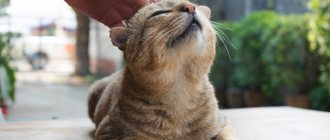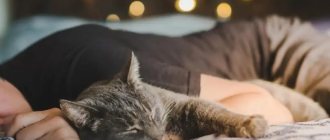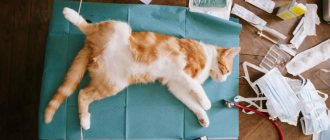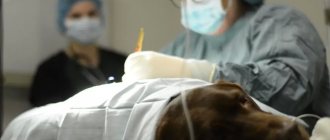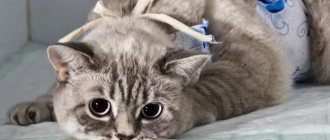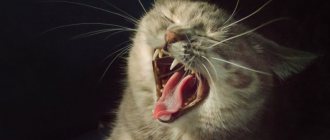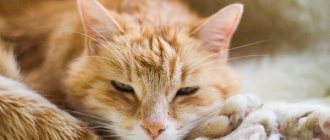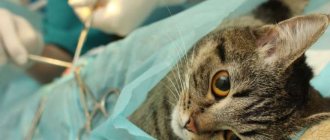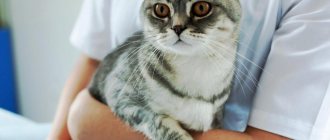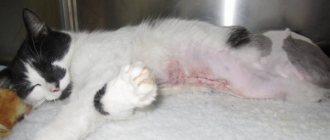Sterilization and castration are popular surgical procedures among cat owners that can solve many problems associated with sexual heat in pets. Despite the fact that these procedures have long become routine, they remain operations after which animals require recovery.
One of the most common post-operative problems is a lack of appetite in your pet. Why doesn't a cat eat after castration or sterilization? When should a tailed friend recover after surgery? How long after it should start eating and drinking? What to do if your pet refuses food and water?
Possible postoperative complications
If a cat does not eat or drink after surgery, this makes the owners worry, so the question arises of how to help their pet and whether this may indicate the presence of serious complications.
After sterilization, it takes time to recover
It is absolutely normal for a cat to eat poorly after sterilization or a cat after castration during the first 24 hours. All the animal does is sleep and sometimes get up to drink some water.
Important! If the animal cannot get up on its own to drink water, then it must be given water periodically.
In addition, there is no need to panic if the cat goes to the toilet under itself or vomits; this is also quite possible until the threads are removed from the seam. Veterinarians recommend that owners do not touch the cat during the first two days and, if it does not want to eat, there is no need to force food. The animal will be able to go without food for several days, while its body will use up previously accumulated calories to maintain satiety.
The postoperative period will be painful for the cat, but it will gradually recover. In addition, she will receive injections to maintain fluid balance.
The animal needs to be allocated a secluded corner that will be quiet and calm so that the cat can rest and get enough sleep. You should definitely put a bowl of fresh food nearby.
Note! If there are other animals in the house besides the cat, they must be isolated until the sterilized animal is completely restored.
If a cat does not eat or drink for several days after sterilization, then you should urgently seek veterinary help, because such a condition may indicate the development of serious diseases.
Postoperative complications may be as follows:
- development of sepsis;
- intestinal atony or obstruction;
- kidney or liver problems;
- hernia;
- inflammation of the peritoneum;
- infectious infection;
- suppuration of the sutures or their divergence.
Complications after surgery can be different.
If even one negative symptom appears, you must seek help from a specialist; treatment at home is unacceptable, because there is a threat to the pet’s life.
The cat began to eat poorly: possible pathologies
Refusal to feed may be due to more unpleasant factors. These include:
- Severe blood loss. In fact, even with a loss of 15-20 ml, the cat will experience severe weakness. Accordingly, if the volume of leaked blood is greater, then the animal physically does not have the strength to eat.
- Intestinal atony. When the peristalsis of the digestive tract is greatly inhibited due to the action of certain drugs used to administer anesthesia. The problem is that in some animals, intestinal contractility is not restored on its own, which is why the pet does not have much of an appetite. In such cases, the cat eats little, but due to the fact that food masses “clog” the lumen of the intestines due to the inability of the latter to push semi-digested food further, severe intoxication develops. Usually the pet drinks greedily, but completely refuses to eat.
- Inflammation. "Classics of the genre". In most cases, it is a consequence of the “rash” actions of the cat herself, who constantly licks and scratches the suture line, introducing infection there. Sometimes inflammatory reactions are a consequence of gross violations of the basic rules of surgical asepsis and antisepsis. Peritonitis is especially dangerous (deadly). This is an inflammation of the peritoneum, often leading to death. The cat's overall body temperature rises sharply, she feels very unwell, and in the worst cases, the stitch begins to smell like pus. It is quite natural that a dying animal does not and cannot have any appetite.
- Sepsis (blood poisoning).
The cat does not eat or drink for a long time: the main reasons for refusing water and food
If the cat feels weak, does not touch food even for 2-3 days
If the cat feels weak and does not touch food even on the 2-3rd day, food is administered intravenously or fed with broth from a pipette.
In the postoperative period, it is recommended to give non-solid, easily digestible foods. If a cat has been eating dry industrial food, it is switched to soft food. Some animals' taste preferences change and they give up their favorite foods.
If the cat does not eat or drink for several days after surgery, this becomes an alarming signal. Sometimes hospitalization is recommended so that the animal is under medical supervision around the clock.
Cats are quite intelligent animals with a decent instinct for self-preservation. They will never eat everything in a row; they are extremely careful when choosing food. But there are times when the appetite completely disappears.
At first glance, it is difficult to determine why a cat has not eaten or drunk for several days. This may also be accompanied by additional symptoms - a serious reason to take emergency measures. You can determine the condition of your pet by its appetite.
Below we have given you a video example where a cat fell ill with distemper and stopped eating and drinking water. Look at the general condition of the cat, perhaps the symptoms may be similar!! In the video, the owner recommends the medications that the doctor prescribed for her. Be sure to consult a veterinarian!
According to veterinarians, temporary hunger strikes in animals are acceptable and not painful. These factors include:
- A kitten may not eat anything for one day. This rule applies to animals under 6 months of age. If he continues to refuse food, adequate measures must be taken.
- Healthy young pets can refuse food for 5 days. This “diet” is absolutely safe for the body, provided there are no obvious signs of illness. If your cat begins to burp, vomit, diarrhea, lose weight quickly, refuse fluids, or a week has passed since her hunger strike, immediately contact the veterinarian!
- An old cat may not eat for three days. A longer hunger strike indicates the development of chronic diseases. In this case, you can’t do without the help of a specialist.
There are other reasons that cause an animal to temporarily refuse food. Let's look at them in more detail in our article and find out why cats refuse food for several days and how to help them in this situation.
The beloved fold-eared pet with a good-natured face and a trusting look suddenly began to refuse his favorite treats. Atypical behavior for pets makes the owner nervous. Naturally, every caring owner tries to find out why a domestic kitten is not eating.
The worst thoughts immediately come to mind, and we intuitively run to specialists for help. However, there is no need to rush; it is necessary to exclude all possible reasons that could cause a change in the appetite of a furry family member.
Pets develop taste preferences over time. They quickly get used to their daily diet and do not always give in to experiments involving a sudden change in diet. If you have recently changed your pet’s usual food to a new composition, your cat may refuse to eat on principle, showing his dissatisfaction. Loss of appetite can also occur due to the introduction of new foods into the diet.
So, unfamiliar food is one of the reasons why a furry family member may go hungry for several days. If the food remains the same, look into your pet's bowl to see if there are leftovers from the previous meal or poorly washed edges.
A clean animal may refuse food after smelling the unpleasant smell of rotting remains. Take care of the hygiene of dishes for your pet. A dirty bowl can not only affect his appetite, but also provoke the development of certain diseases.
You feed it its usual food, thoroughly clean the bowl after each feeding, follow all the doctor’s recommendations, but the animal does not develop an appetite. The cat refuses to eat, and the cause of this condition may be stress or pain.
What is this connected with? There is no definite answer; you will have to draw your own conclusions. Stress in cats occurs for various reasons:
- moving to a new home;
- rearrangement of furniture in the house;
- replacing the usual dishes with another;
- the appearance of a new family member in the house, etc.
In such an environment, the cat can feel safe and eat. Be sure to provide her with something to drink. If she continues to refuse food for more than 3-5 days, contact your veterinarian. An experienced doctor will be able to determine the exact cause of the hunger strike and find a solution to this problem.
A domestic cat may not eat well if it has dental problems. This cause of loss of appetite is very common. A clear sign of pathology: the animal may drink a lot of liquid, choke on food, burp after eating solid food, etc. Loss of appetite occurs due to a lack of teeth in a row, which provokes the development of certain diseases of the gastrointestinal tract.
The source of such problems can also be dental caries, gum disease, tartar accumulation and other dental ailments typical of humans. To prevent such conditions and not to risk the health of a purebred cat, carry out hygienic care of its oral cavity in a timely manner. If you detect obvious signs of an inflammatory process, consult a doctor.
If dental disease has already caused loss of appetite in your beloved cat, try to choose the optimal set of foods for feeding. Eliminate solid foods, grind all food served, and be sure to consult your veterinarian. Your friend may need medication help.
You can understand that an animal has been poisoned if the cat refuses to eat for several days, which is also accompanied by a gag reflex, lethargy, muscle tremors and other unhealthy signs. Due to poisoning and painful symptoms, the cat may hide, meow loudly, or simply lie down without showing active signs of life. Any atypical symptoms should not be ignored.
Poisoning can be caused by various chemicals, low-quality products, medications, etc. A dangerous substance could enter the animal’s body accidentally or intentionally. A cat can swallow bait containing poison, which is possible if the pet has free access to the street.
| Video (click to play). |
The culprit of this process can also be the owner of a furry friend, who unintentionally fed the cat spoiled food or food containing components unsafe for the animal.
If the reason for refusing to eat is poisoning, it is necessary to take urgent measures to save the four-legged family member! An experienced veterinarian will prescribe effective treatment so that your pet can recover.
The main thing is not to hesitate, since in case of poisoning with chemical poisons, irreversible processes in the body can begin, which lead to the most unfavorable prognosis.
Poor appetite in a domestic cat may indicate the development of pathological processes in the liver, kidneys and urolithiasis, which often occurs due to poor quality nutrition. According to statistics, such diseases are diagnosed in felines three times more often than in dogs.
You can determine exactly what the problem is by the following symptoms:
- the cat behaves lethargically, the condition noticeably worsens;
- can drink large amounts of water at one time;
- there is an unpleasant odor from the mouth;
- frequent urge to urinate;
- there are blood impurities in the urine;
- vomit;
- convulsive conditions;
- elevated temperature;
- weight decreases;
- if you stick out your tongue, you will notice an uncharacteristic yellow coating;
- increased salivation;
- anemia and signs of dehydration.
With such symptoms, the animal must be urgently shown to a specialist!
Forecasts for the animal:
- Kidney diseases can be treated if promptly consulted by a veterinarian;
- if the disease is advanced, there is a possibility of becoming chronic, which will require regular support for the cat’s health to prolong and improve the quality of its life;
- With liver diseases, obesity is observed, which also negatively affects the general condition of the pet and shortens its lifespan.
Even if your cat is sick, do not rush to part with your furry friend. Provide her with the necessary help, provide care and love, because any disease can be treated, especially if you are next to her during this difficult period!
What to do if your domestic cat does not eat at all due to a foreign body entering the stomach:
- do not try to feed your pet (severe vomiting may occur);
- do not do an enema yourself (there is a risk of serious damage to the intestines);
- do not give your cat antiemetics or laxatives, as they will not solve the problem and will only worsen the general condition;
- Seek help from a qualified veterinarian as soon as possible!
Any foreign body can enter the animal's body, including indigestible sausage skins, scraps of wool and bones. This is a very dangerous condition for the animal, known as intestinal obstruction. If timely medical care is not provided, there is a high risk of death.
The death of a pet occurs due to the release of gastric juice and its stagnation in the intestines. An unfavorable process is accompanied by vomiting, the abdomen becomes enlarged, and when pressure is applied the cat experiences severe pain. Do not try to solve the problem yourself; any wrong action can lead to irreversible consequences.
About proper watering and feeding
As practice shows, approximately half of the normal amount of food and water can be given to a cat within 12 hours after returning from the clinic. But only if there are no separate instructions from your veterinarian.
In principle, an animal under 16 weeks of age recovers relatively quickly from surgery, and at this time it can be safely fed a “half” food norm. What to do when the animal doesn’t have much of an appetite? In this case, you can try to interest him by using a small amount of sugar (ideally maple) syrup.
To do this, take a cotton swab, lightly moisten it with a sweet solution and thoroughly wet your pet's upper lip with it. She will lick up the liquid and her appetite will probably be aroused. Feeding your cat will become much easier. Keep in mind that in cases where the animal is taken from the clinic in the evening or even at night, it will not have an appetite until the morning, and this is a completely normal physiological reaction of the body. Do not try to force water and food, the animal will probably eat on its own in the morning.
It is generally not advisable to leave anything other than a small volume of clean drinking water overnight. Offer the first portion of food in the morning, carefully observing your pet's behavior and possible pathological effects. If during this time (or after feeding) your cat begins to vomit or have profuse diarrhea, contact your veterinarian immediately, as there is nothing you can do at home.
When removing the ovaries and uterus, veterinarians use quite powerful and serious drugs. Therefore, in the postoperative period, under no circumstances give your animal any medications without first consulting with a specialist. The interaction of various drugs can lead to unpredictable consequences. If a specialist has prescribed any medications for your pet, be sure to strictly (!) follow all the veterinarian’s advice and recommendations.
Anesthesia is the cause of lack of appetite
Cat after sterilization: care at home
During surgery, veterinarians use general anesthesia as it helps numb the surgical site. Another advantage of anesthesia is that the cat will not escape from the operating table and will not inflict even greater injuries or mutilation on itself.
But the effect of anesthesia after the operation does not go away without a trace, and the cat recovers from it for a long time: it may take a long time to wake up, breathe heavily, eat nothing and move unsteadily - and all this is the norm.
In rare cases, an animal can be in a comatose state for a week: refuse to eat, sleep constantly and practically not move. But all this goes away over time without additional help.
If a cat does not drink water after anesthesia, then this is also quite normal, since it may vomit after drinking water or food. Therefore, you should be patient, and very soon your pet will recover.
Signs of dehydration
If a cat stops drinking water after sterilization, it is necessary to conduct a thorough examination in order to recognize the early stages of dehydration and take measures to prevent it.
The first symptoms in the form of dryness of the oral mucosa indicate a loss of 6 to 7% of fluid. To establish this, the condition of the gums should be assessed. If normally a healthy gum should be moist and elastic, then with a lack of moisture it becomes dull, pale and dry.
Important! By pressing on the gum, you can see the formation of a poor area on it, which normally turns pink within 1-2 seconds. Paleness that persists for more than 10 seconds indicates severe dehydration and requires immediate action.
Other warning signs include:
- dryness of the conjunctiva and cornea of the eyes;
- redness of the eyelids;
- cold extremities;
- severe weakness accompanied by tremor (shaking) of the limbs.
Preparing for surgery
To minimize risks, the cat must be checked, undergo the necessary tests, and, if everything is in order, prepared for surgery.
Since cat spaying is an operation that is done under general anesthesia, it is best to schedule it in the morning so that you can keep an eye on your cat while she recovers from the anesthesia, which will take several hours. Prepare in advance the place where you will place the cat after the operation, and the basket with which you will bring the cat home.
The cat will tolerate anesthesia more easily on an empty stomach, so 12 hours before the operation it is necessary to put the cat on a forced hunger strike. You need to take this seriously: a hunger strike will help avoid vomiting during surgery and reduce the load on the animal’s heart. Get your pet's stomach to empty; consult your veterinarian about how to do this. The cat can be given something to drink 3 hours before surgery.
How to help your pet?
There are a number of recommendations from veterinarians for the process of cat rehabilitation at home:
- you need to put the pet on the floor, since due to impaired coordination of movements after anesthesia, it may fall from a hill;
- the cat should not lie near heating appliances - this can cause internal bleeding;
- It is worth laying down an absorbent diaper, as the cat may spontaneously urinate, defecate or vomit;
- you need to put the pet on its right side to reduce the load on the heart;
- if a cat has a weakened immune system, it needs a course of vitamins and restoratives;
- in the first hours after surgery, it is necessary to measure the cat’s temperature once an hour and carefully turn it over every half hour to avoid numbness in its paws;
- if ulcers, crusts, rashes or redness form in the suture area, consult a veterinarian;
- in case of sudden vomiting, it is necessary to turn the cat’s head to the side and make sure that it does not choke;
- to prevent licking and scratching of the stitches, as well as to protect the wound from dust and dirt, you need to put a postoperative blanket on your pet;
- stitches must be treated in accordance with the recommendations of the veterinarian.
If all recommendations are followed, the cat will recover from anesthesia easier and recover faster.
What to do if the animal refuses to eat
Owners begin to worry if the cat does not eat after surgery, what to do in such a situation and why does this happen? In this case, you should consult a specialist, as complications may arise.
How long does it take for a cat to recover from anesthesia after sterilization: how you can help
The animal must be fed three times a day with kefir, broth or meat puree, but in small portions. This can be done using a syringe without a needle, pouring food carefully into the cheek. It is also recommended to place an intravenous drip with nutrition.
Important! If the cat does not eat anything or go to the toilet for a long time, it means that some complication could have developed.
It is very important to ensure that your cat goes to the toilet regularly, because constipation can cause her to refuse to eat. To determine whether the cause is really constipation, it is worth palpating the stomach and, if there are lumps, give an enema or give the animal a laxative.
Refusal to eat after surgery usually lasts several days
After the operation, the cat must be wearing a blanket, which prevents licking the wound and scratching it. The owner’s task in this case is to care for the wound, since its deterioration can also affect the animal’s complete lack of appetite.
If no complications were confirmed by the veterinarian, then after 10 days the pet will be able to fully recover and begin to eat normally.
Consequences of sterilization
Owners should be concerned about the following consequences of sterilization:
- lethargy and apathy;
- impaired coordination of movements;
- excessive thirst;
- unnatural posture when the pet is lying down;
- desire to hide, photophobia.
The animal’s need for fertilization should also be of concern. This is possible with incomplete castration, when the ovaries continue to function, but the cat cannot become pregnant. Nevertheless, she wants to.
Sometimes after sterilization, cats begin to mark their territory. This is caused rather by psychological reasons: this is how they assert themselves, because the reproductive instinct has been lost. This habit may go away over time, otherwise the animal will have to be weaned off it.
If a pet meows loudly after surgery, she reports that she is in pain and uncomfortable.
How long after the procedure should a four-legged patient start drinking and eating?
If the operation is successful, the operated animal drinks water and eats on its own on the second day. During this period, it is recommended to feed your four-legged pet in small portions. In the first few days after surgery, your pet's appetite may be significantly reduced. Normally, it should fully recover within 6–7 days. By this time, most animals are already beginning to experience the same interest in food, and their bowel and bladder emptying processes are normalized.
Rehabilitation process
Full recovery of the cat’s body usually occurs in 10-15 days. There are several recommendations for care during this period:
- It is necessary to wear a postoperative blanket to protect the stitches from licking and scratching. Prevents dirt or toilet litter from entering the wound. It is recommended to purchase a blanket made of durable but breathable material. Tie tightly, but without over-tightening. The blanket should not restrict movement.
- The healing process of postoperative sutures must be monitored. Stitches can be ordinary or cosmetic. In the first case, it is necessary to remove the stitches within the time prescribed by the veterinarian. This procedure is not required with cosmetic sutures, as they are made of absorbable material. The condition of a seam can be determined by how it looks. There should be no severe redness or swelling. To prevent bacterial infection, it is necessary to treat the seam as recommended by your veterinarian.
- The room where the animal is located during the rehabilitation period must be as safe as possible. When a cat jumps onto a window sill or chair, it can get its blanket caught on protruding parts. If the seam comes apart, you will have to reapply it.
- One of the complications after surgery is bowel dysfunction (constipation). If after two to three days the cat still does not go to the toilet, you can resort to a laxative (veterinary drugs) or Vaseline oil. Lack of results is a reason to contact a veterinarian.
Feeding after surgery
In order for your cat to recover quickly after surgery, you should monitor its diet. Proper nutrition is the key to a quick recovery and prevention of complications.
The cat does not drink water at all: what to do, why
During the first two days, the animal may not eat anything at all, and this is normal. During the first day, the cat should not be given solid food; it is better to cook broths or soups. On the second day, you should start feeding with soft food or crush the food into a puree. It is recommended to feed in small portions 3-4 times a day.
After surgery, the animal loses a lot of minerals and vitamins and it is very important to compensate for their deficiency in the body, so experts recommend buying special cat food that has high nutritional value and a balanced composition.
If the animal eats homemade food, then you should avoid foods with a strong smell and spices. It is also prohibited to give dry food during the postoperative period; it must be pre-soaked with water, but the main emphasis after the operation should be on eating canned meat and purees.
Important! When feeding your cat, you should make sure that the food is neither hot nor cold. It should be at a comfortable temperature for consumption.
Wound care and treatment
Postoperative sutures usually do not cause discomfort to the animal. But curiosity takes over, so often the cats themselves become the culprits of unpleasant consequences. Therefore, you should not let your cat disturb the wounds. A little effort is also required from the owner to ensure that the animal endures the adaptation period after surgery as easily as possible.
Simple tips to help you heal quickly:
- Treat seams with brilliant green or hydrogen peroxide at least 2 times a day. As a supplement, you can use levomekol ointment; it is used as an antibacterial and healing agent.
- To prevent the animal from touching the surgical site, wear a special diaper.
- A five-day course of antibiotics to prevent infection.
Cats' bodies are very similar to humans, so provide them with care and attention. Even small wounds need to be treated, and even more so after surgery.
The appearance of pathogenic bacteria can only be avoided by treatment.
If all this is done, then in a short time the animal will begin to delight its owners with a wonderful mood.
How to process seams
It is very important to keep the seams clean and prevent infection and inflammation. The bandage should be changed to a clean one every day, and the seam should be treated daily with the antibacterial agent “Argumistin”, which will prevent inflammation, fungus, and infection with microbes during periods of particular danger.
The use of "Argumistin" has a number of advantages:
- eliminates the main cause of the disease;
- has an anti-inflammatory effect;
- activates the regeneration process;
- does not contain antibiotics;
- does not cause addiction in cats;
- ease of use;
- optimal price.
Monitor the progress of healing, treat the sutures daily, and in case of the slightest deviation, consult a doctor. The sooner complications are detected, the easier it is to prevent possible danger.
Veterinarian advice
A sterilized cat may not eat for 2 days. Calorie reserves will be enough to provide the body with nutrients for this period.
Veterinarians recommend waiting and not force-feeding your pet. If after 2 days the cat does not have an appetite, it should be shown to a doctor.
Further advice from veterinarians is individual and depends on the diagnosis that will be given to the animal.
All information posted on the site is provided in accordance with the User Agreement and is not a direct instruction to action. We strongly recommend that before using any product, you must obtain a face-to-face consultation at an accredited veterinary clinic.
Rules for feeding a sterilized cat
It is necessary to start feeding the cat only 12 hours after surgery, since during this time the animal’s gastrointestinal tract does not work well, and it may vomit after eating.
When compiling further menus, it is imperative to take into account how the animal ate before sterilization. The most acceptable are cat foods, since they contain balanced components necessary for a pet.
Food for a sterilized cat
- First day. A cat does not eat well after sterilization for 24 hours; this is normal. This is the period when the animal is completely exhausted and cannot show interest in food or water. You can give your cat water a few hours after the operation, but before that you can only moisten a little sponge or drop a couple of drops of water on the tongue to avoid dehydration.
- Second day. If there are no complications, the animal may begin to show interest in food, and it is worth feeding it with special cat food. You should choose those whose action is aimed at restoring the body after operations or illnesses. It is worth opting for canned food such as Royal Canin, Hill's, Purina, etc. But if before the operation the animal was home-fed, then it should be boiled chicken broth and add a little twisted meat.
- The third day. The cat should begin to eat on its own without any help. But if this is not observed, you should pay attention to the pet’s behavior. If she meows, there is an unpleasant odor coming from the stitches, or the wound is bleeding, then the animal should be immediately shown to a doctor.
- Fourth day. If the cat still does not eat anything, then this most likely means the presence of complications such as peritonitis, sepsis or problems with the gastrointestinal tract. If the cat ate normally for the first four days, and then suddenly began to refuse to eat, this may mean the occurrence of delayed intestinal atony or problems with the liver or kidneys. The fourth day without food after surgery may mean that the cat is dying, so you need to drop everything and run with it to the veterinary clinic.
- Fifth day. You can already start giving everything that the animal ate before surgery. But if during the first five days the cat took food reluctantly, and sometimes even refused it altogether, then it can lose a lot of weight, and in this case it is necessary to introduce high-quality food into the diet and take additional medications that are prescribed only by a veterinarian.
Many animals recover easily and quickly after surgery.
If the cat does not drink after sterilization or does not eat anything after two days, then you should seek help from a veterinarian, who will identify the complication in time and give further recommendations for treatment.
Fourth day
A situation where an animal refuses food for 4 days is unlikely. If this happens, this indicates severe pathologies:
- sepsis;
- peritonitis;
- gastrointestinal diseases (for example, intestinal atony).
A cat that doesn't eat for 4 days in a row is most likely dying. She needs urgent veterinary attention.
It happens that the first few days everything is fine with appetite, but on the 4th day it disappears. This may be due to delayed intestinal atony or the reaction of the liver and kidneys to the administration of anesthetic drugs.
How to process seams
It is very important to keep the seams clean and prevent infection and inflammation. The bandage should be changed to a clean one every day, and the seam should be treated daily with the antibacterial agent “Argumistin”, which will prevent inflammation, fungus, and infection with microbes during periods of particular danger.
The use of "Argumistin" has a number of advantages:
- eliminates the main cause of the disease;
- has an anti-inflammatory effect;
- activates the regeneration process;
- does not contain antibiotics;
- does not cause addiction in cats;
- ease of use;
- optimal price.
Monitor the progress of healing, treat the sutures daily, and in case of the slightest deviation, consult a doctor. The sooner complications are detected, the easier it is to prevent possible danger.
Conjunctivitis in dogs
Endometritis in dogs
Diabetes mellitus in cats
Endometritis in cats
Medicinal support
All medications must be approved by a veterinarian!
Painkillers:
- Rimadyl (carprofen) – intravenously or subcutaneously at a dose of 4 mg/kg (equivalent to 1 ml/12.5 kg of weight) once a day;
- Tolfedine (tolfenamic acid) – 4 mg/kg once a day orally with food;
- Ketofen 1% (ketoprofen) – subcutaneously, intramuscularly or intravenously at a dose of 2 mg/kg (or 0.2 ml/kg) once a day and no longer than 3-4 days;
- Loxicom (meloxicam) – 0.1 mg suspension/kg orally on the first day once, 0.05 mg/kg on subsequent days.
Seam treatment products:
- Chlorhexidine 0.05% (aqueous solution) - water the seam through a dispenser or drip from above using a pipette until healing;
- Dioxidine 0.5% - use similarly to Chlohexidine;
- Veteritsin spray - spray the suture area 1-2 times a day before removal;
- Aluminum spray - spray on the seam every few days until healing;
- Chemi spray - treat the seam once a day until healing;
- Levomekol ointment - apply around the wound once a day, under a bandage.
Antibiotics:
- Sinulox (amoxicillin + clavulanic acid) – intramuscularly once a day at a dose of 0.5 ml/10 kg for 3-5 days;
- Amoxicillin 15% – subcutaneously or intramuscularly 1 ml/kg (in terms of 15 mg/kg) once for 5 days.
What is important to pay attention to?
It is not recommended to leave a cat unattended near water bowls, mugs and other utensils with water. Basically, after sterilization, a cat drinks little, but animals still have situations of excessive thirst, so there are certain risks. After sterilization, the animal’s swallowing reflex is disrupted; it drinks water inaccurately , so it may choke. Or just fall asleep with your head falling into a bowl of water. In this case, the owner will need to monitor the pet’s behavior in order to prevent this from happening.
Liquid intake rate
Do not worry ahead of time, because increased thirst does not always mean the presence of a serious pathology in the cat’s body. Veterinarians do not have water consumption standards. Indicators depend on many factors - age, physiological state, climatic conditions, nutrition, etc.
The amount of moisture required for the body can be calculated approximately: 0.03 ml of liquid per 1 gram of cat’s body weight. Moreover, you need to count not only water, but also wet food, milk, broth, etc.
Veterinary experts say that each cat has its own water consumption rate. You can determine that she has enough fluid by the animal’s behavior. If the cat is cheerful and active, eats with appetite and does not lose weight, then everything is in order with his health.
Why does a cat need water?
Unlike other animals, cats - tigers, lynxes, leopards, panthers and other species of this kind of predators - can get by with a small amount of liquid: they lose less water during breathing than, for example, representatives of the canine family. But the need for water is also vital for low-drinking cats; water balance directly affects their vital activity and vitality.
An inorganic compound called hydrogen oxide makes up 65% of a cat's body weight. Water enters the structure of cells and extracellular fluid, transports nutrients and oxygen to tissues, and participates in thermoregulation. If the natural loss of fluid is not replenished, this can lead to disruption of metabolic processes, and prolonged dehydration can lead to irreversible changes in the internal organs and death of the animal.
The cat's daily water requirement is approximately 60 ml per 1 kg of weight. That is, a three-kilogram cat needs to drink half a glass of liquid per day. This includes clean water the cat drinks and water contained in wet food or soup.
Proper nutrition
A speedy recovery for a pet after intoxication is impossible without following a proper diet. What to feed a cat after poisoning is a concern for every responsible owner. As a rule, after an illness the animal loses its appetite for a long time.
However, special attention should be paid to nutrition issues
Veterinarians recommend a 24-hour fasting diet after poisoning an animal. A therapeutic fast will help the body cleanse itself of toxic substances and restore digestive function.
Due to the fact that many toxic substances are highly soluble in fats, at first you should not give the animal food containing them. Only vegetable fats are allowed in small quantities. This issue is especially relevant when phosphorus-containing substances (usually pesticides) and rat poison enter the body. For the same reason, you should not feed your animal milk. In addition, fatty foods will slow down the recovery of the liver, which suffers from any poisoning of the body.
Therapeutic food for a cat after poisoning should be gentle on the digestive system. Experienced breeders recommend feeding your pet during the recovery period 3 - 4 times a day for 1.5 - 2 months after poisoning.
Congee
If intoxication has occurred due to eating poor quality food, then after a daily fasting diet the animal should be given rice water. It is prepared in water.
After 2 - 3 days, the pet can be offered viscous porridge based on rolled oats and pureed buckwheat. You should not feed a sick cat pearl barley, semolina, or corn porridge.
Gradually, you can add boiled vegetables (carrots, broccoli, pumpkin) to your diet. After 5-7 days, if the pet’s condition is satisfactory, lean poultry and rabbit meat can be introduced into the diet. The meat should be given boiled, in small pieces or crushed in a blender until pureed. Fatty fish, table food, and canned food are strictly contraindicated.
You can give your animal low-fat cottage cheese. You should abstain from milk, cheese, and sour cream for the first 2 to 3 days. It is useful to give low-fat kefir if there is no digestive upset.
If before poisoning the animal was fed with ready-made formulas, during the recovery period it is recommended to give super-premium medicinal food, for example, Hills I/D for food poisoning, Hills L/D for liver problems due to toxic substances or K/D, if the kidneys were damaged by poisoning.
In the Royal Canin food line, you can use the Gastro Intestinal composition, which ensures maximum digestive safety, as well as Hepatic food, which supports liver regeneration. A veterinarian will help you choose one or another medicinal food, taking into account the type and form of poisoning.
Cat food recommended for consumption after poisoning
Owners often note that after poisoning the cat does not eat. After severe intoxication, this phenomenon is often observed. If there is no appetite for 2-3 days, you should not force feed the animal, as this may provoke vomiting. If the general condition of the sick pet is weakened, it should be regularly taken to the veterinary clinic for the administration of intravenous nutrient solutions. For this purpose, infusions of 40% glucose solution and saline are used.
When can you give a cat water after sterilization?
When picking up your cat from the clinic, you should check with your veterinarian when you can drink water after sterilization.
Typically, experts do not recommend giving the animal water within three hours after waking up from anesthesia. This is justified by the physiological factors of the body and the characteristics of the effects of narcotic drugs on the central nervous system.
- Under the influence of anesthesia, the swallowing reflex is partially suppressed, the recovery of which takes 2 to 3 hours. Impaired swallowing function can lead to fluid entering the respiratory system, which subsequently triggers the development of pneumonia. And when a large amount of water is swallowed, suffocation occurs.
- Toxic substances included in narcotic drugs, irritating certain centers of the brain, cause attacks of nausea. Water your cat drinks can cause vomiting, which causes severe tension on the abdominal walls, leading to suture dehiscence or internal bleeding.
Important! The water in the bowl should be at room temperature or slightly warm, as cold liquid can cause a sharp spasm of the throat, esophagus and stomach, causing vomiting.
General information about the procedure
Sterilization is an operation that results in the removal of the uterus and ovaries in females and testes in males. It would be more correct to call the procedure castration, however, to soften the perception of owners, the concept was replaced by the term sterilization. As you know, a fairly large number of owners vehemently oppose the sterilization of pets, but they are guided mainly by common myths.
Let's figure out what changes in the animal's behavior to expect immediately after surgery and after a long period of time. As part of the questions, it is worth touching on the myths that frighten inexperienced owners and make them refuse to castrate their pets.
This is an abdominal operation that is performed under general anesthesia. In large, modern veterinary clinics, the procedure is performed laparoscopically. The advantages of the laparoscopic method are that there is no suture; the uterus and ovaries are removed through two small punctures in the peritoneum. Since laparoscopic surgery is considered expensive, most owners opt for strip surgery.
To avoid serious complications, before sterilization, it is recommended that the cat be examined for heart, kidney and liver failure. Serious complications can be caused by immunodeficiency, exhaustion, dehydration and other disorders leading to suppressed immunity or slowed metabolism.
Reasons why a cat may refuse to drink
Possible reasons for a cat refusing water may be:
- The amount of fluid required for the body comes from food. This is quite realistic if the cat prefers homemade soups to ready-made dry food.
- Unpleasant odor or taste of water. A cat may refuse to drink from a dirty bowl; it will not drink water that was poured so long ago that it has already suffocated and smells bad. Dishes made from cheap plastic can give water an unpleasant taste. Some cats cannot tolerate the smell of bleach, which is often present in tap water.
- The proximity of the water bowl to the litter tray. Cats have a very keen sense of smell, and water has the ability to absorb odors.
- The water is very cold. This is a rare reason why cats refuse to drink it - even ice-cold water in the room quickly warms up.
A change of scenery. Moving to another home in itself is stressful for the animal. And in most cases, a change of place of residence is accompanied by a change in the taste of water. If a cat lived in a village and was used to drinking soft well water, it will be difficult for her to get used to city water with a high degree of hardness.
The most dangerous reason for a cat to refuse water is illness or injury. This could be a bone stuck in the throat, a disease accompanied by vomiting, diarrhea, and swelling. In this case, dehydration occurs much faster, and along with the fluid, the body loses the macro- and microelements it needs, which are very difficult to replenish.
The animal's drinking regime in the postoperative period, in particular after sterilization, deserves a special approach. Experts recommend not giving the animal water for three hours after recovery from anesthesia. Approximately this amount of time is required to restore the swallowing reflex suppressed by narcotic substances and eliminate possible nausea. If the cat does not want to drink for more than a day after surgery, he is given subcutaneous or intravenous injections of saline to prevent dehydration.
A cat's refusal to drink water within 2 days after surgery is grounds to immediately contact a veterinarian. He will conduct a thorough examination: measure the temperature, examine the mucous membranes, palpate the abdomen (to see if there are any lumps there), and, if necessary, prescribe laboratory tests.
Problems when wearing a postoperative collar
A collar that is too large or heavy for a cat will greatly impair coordination: it will be difficult and even impossible for him to jump anywhere, pass between objects, eat and drink.
An excessively tight collar will lead to hypoxia - oxygen starvation of the brain, poor circulation, chafing of the skin at the point of contact, and damage to the coat.
An animal can remove an excessively loose collar, or it will slip lower and complicate movement.
It is unacceptable to buy collars with a strong “chemical” smell. These products are of low quality and your cat may be poisoned by wearing them.
Buying a collar for a kitten to grow into is not the best solution. A young animal will feel uncomfortable in a bulky structure designed for an adult. A collar is not such an expensive thing to buy for future use. It is better to select it individually each time than to squeeze a large cat into a small collar or try to attach a device purchased for an older cat to a “teenager”.
The sharp edge of the collar at the point of contact with the cat’s body should be covered with an adhesive plaster on a fabric basis.
The collar must be removed periodically to allow the animal to run freely and restore muscle tone. It would be good to put a blanket on a cat after abdominal surgery. The animal must not be left unattended while the collar is removed.
A protective collar for cats is necessary for various types of medical interventions. It preserves the health of the animal, being a necessary measure in the postoperative period and during conservative treatment with drugs for external use. The cat quickly gets used to the inconvenience of wearing it. In addition, a properly selected protective collar almost does not cause them.
Should I put a special blanket on my cat?
All cats are different, so it is impossible to predict their reaction to sutures. Some animals do not even notice their stitches, and most of their owners often voice that the cat has licked the stitches. The owner must protect the stitches as much as possible from the cat itself, since she can infect them with various bacteria contained in her saliva.
To do this, use a special blanket, which should fit well and not dangle on the pet’s body. If a seam is torn or swollen, its character changes, and you are unable to process the seams and make dressings yourself, be sure to contact a specialist. The blanket can be removed only after the stitches have completely healed.
